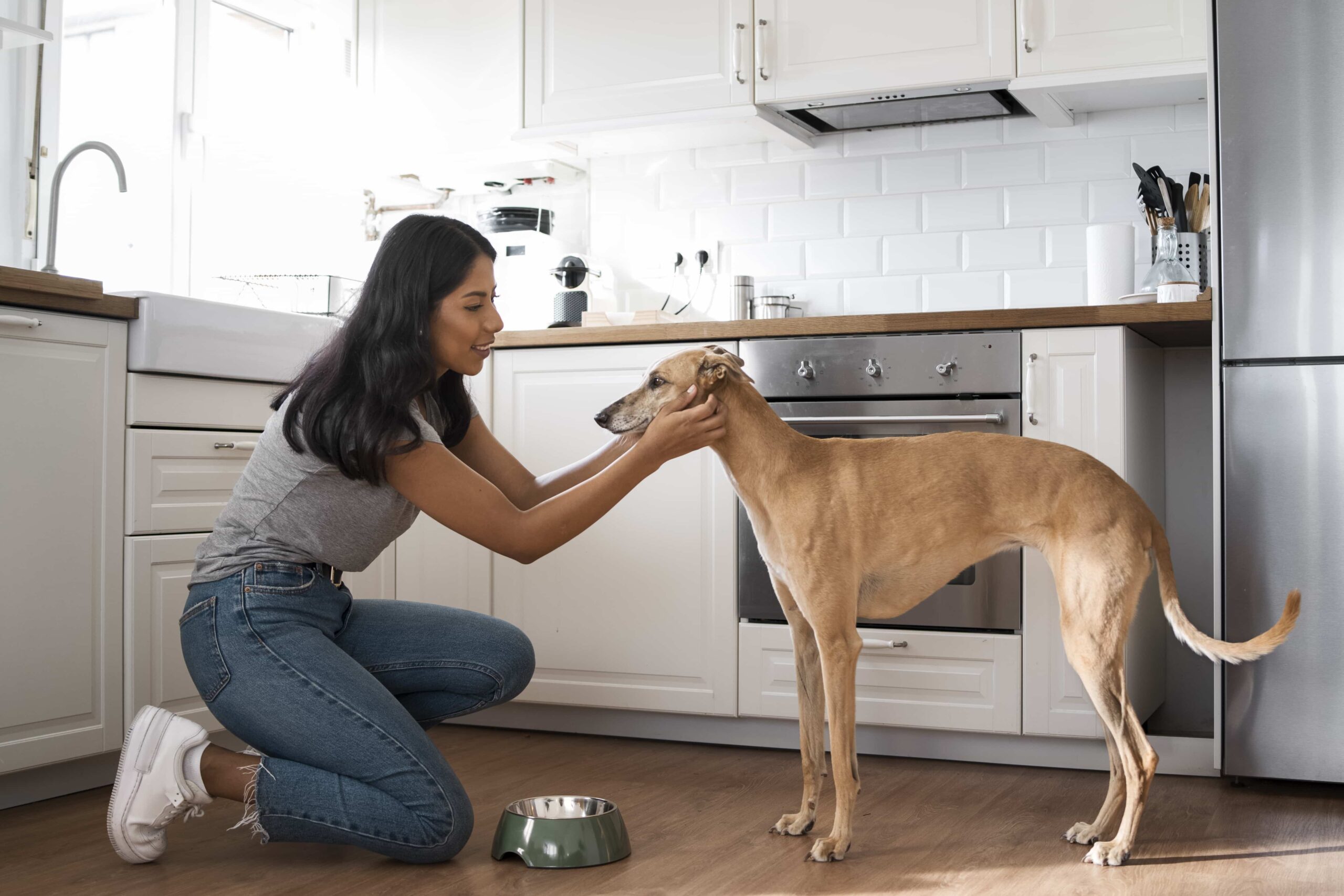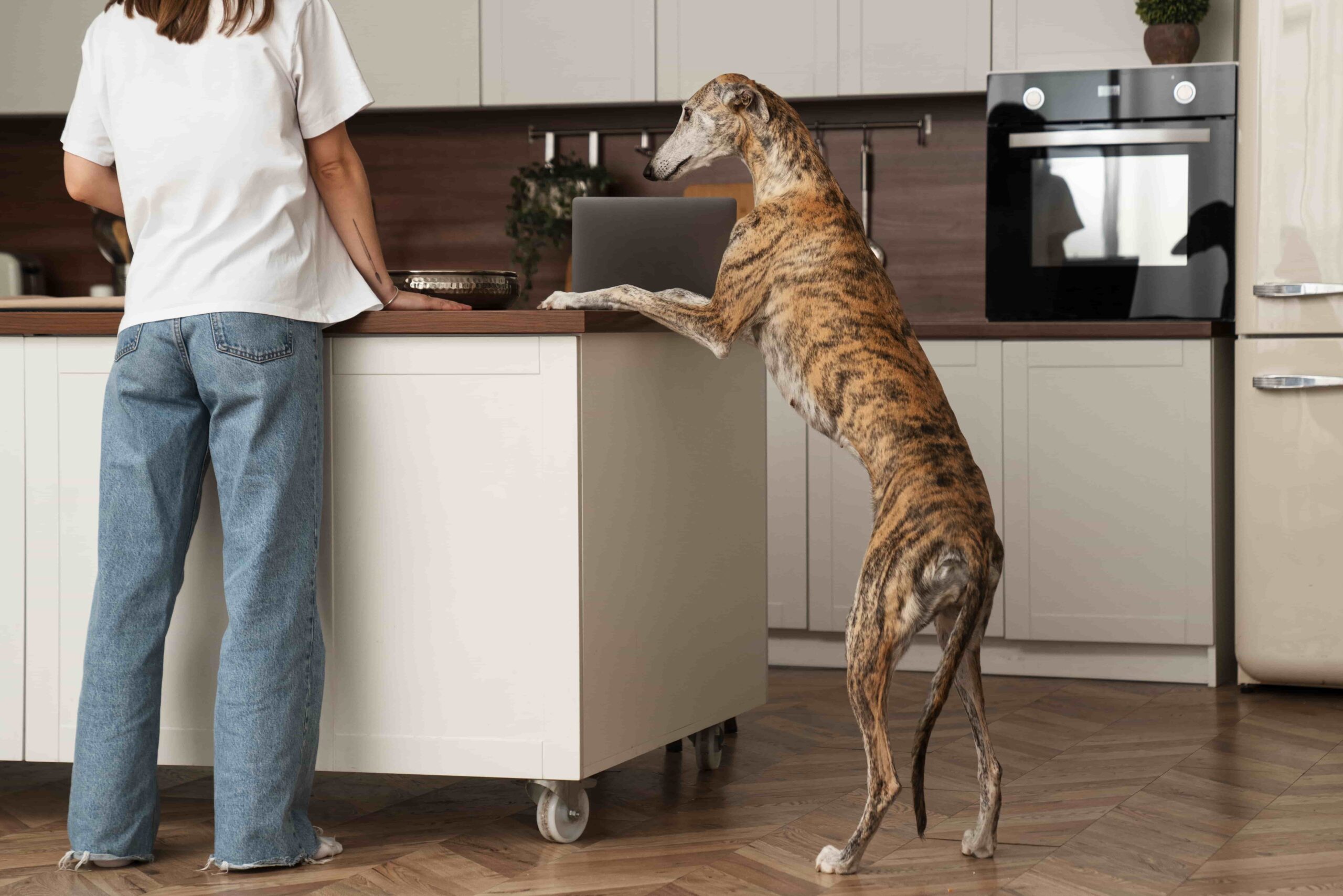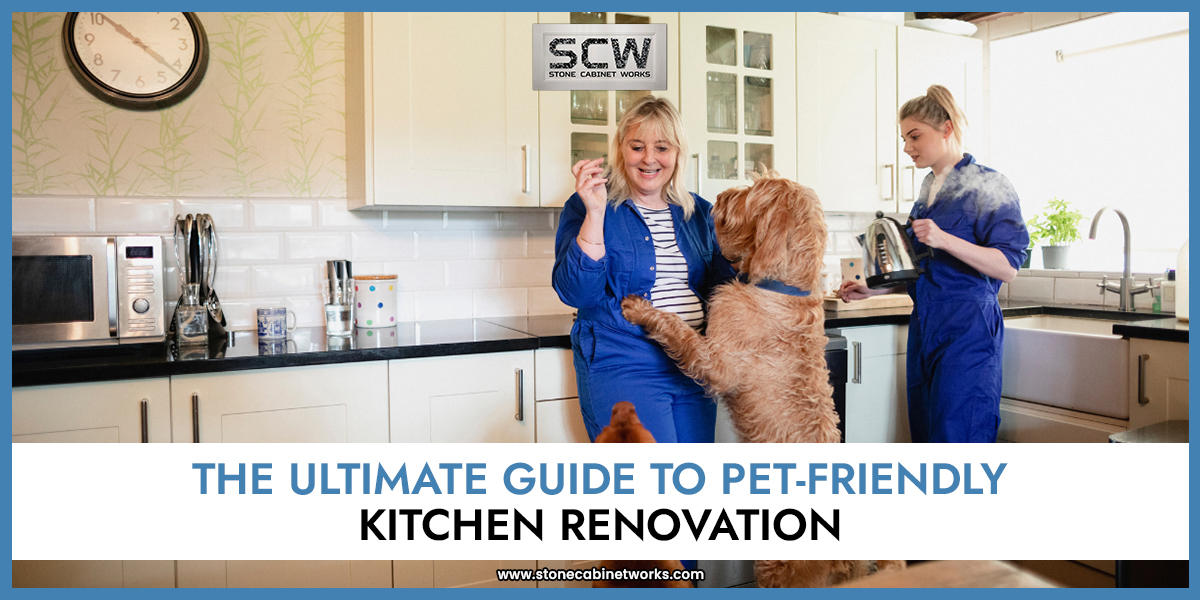For many of us, pets are like family. They live in our homes, share our quiet times, and are often in the kitchen with us. That’s why when you decide to update your kitchen, it makes sense to think about making it not just look good and work well for your family, but also be safe, comfy, and easy for your pets. Making a kitchen that’s good for pets is more than just making it work. It means carefully choosing how things look, picking strong and safe materials, and coming up with smart ideas that fit your pets’ special routines and what they need. This guide will cover everything you need to know to create a pet-friendly kitchen.
1. Use Pet-Proof Flooring

The kitchen floor bears the brunt of daily life, and for pet owners, this wear and tear can be amplified. Accidental spills during excited mealtimes, muddy paw prints after outdoor adventures, and the occasional scratch from playful antics all contribute to the demands of pet-proof kitchen flooring. Choosing the right material is the crucial first step in a pet-friendly renovation.
-
Flooring Options That Are Best For Durability & Cleanliness
1. Luxury Vinyl Plank (LVP) and Luxury Vinyl Tile (LVT)
These engineered options are best for pet owners due to their exceptional durability, impressive scratch resistance, and complete water resistance. Look for higher wear layers to ensure longevity. Both LVP and LVT are also relatively comfortable underfoot and come in a vast array of styles mimicking hardwood, stone, and tile. Their smooth, non-porous surfaces make cleaning up spills and pet accidents a breeze with simple sweeping and mopping using pet-safe cleaning solutions. Consider textured LVP for enhanced grip, but avoid overly deep textures that can trap dirt.
2. Porcelain and Ceramic Tile
Renowned for their robustness and water resistance, these tile options are another excellent choice. Porcelain is denser and less porous than ceramic, making it even more resistant to staining and scratching. Opt for tiles with a matte or textured finish to provide better traction for your pets and reduce the risk of slips, especially when wet. Smaller tiles with more grout lines can also enhance grip. Ensure your grout is properly sealed with a high-quality, non-toxic sealant to prevent moisture absorption and staining, which can harbor bacteria and odors. Epoxy grout is a more durable and stain-resistant option compared to traditional cementitious grout.
-
Flooring to Proceed with Significant Considerations
1. Hardwood
While undeniably beautiful, traditional hardwood is susceptible to scratches from pet claws and water damage from spills or tracked-in moisture. If your heart is set on hardwood, opt for the hardest varieties such as cherry or maple and invest in multiple layers of a robust, water-based polyurethane sealant specifically formulated for pet owners. Be prepared for more diligent maintenance, including immediate spill cleanup and potential refinishing over time. Consider using large, strategically placed rugs in high-traffic areas and around food and water bowls.
2. Laminate
While more scratch-resistant than hardwood, laminate can still be susceptible to water damage if spills aren’t cleaned up promptly, as the core material can swell. Look for water-resistant or waterproof laminate options specifically designed for kitchens and homes with pets.
-
Things to Consider Beyond Material
1. Slip Resistance
Prioritize flooring options with good traction to prevent slips and falls, especially for older pets or those with mobility issues.
2. Noise Level
Harder surfaces like tile and concrete can be noisy when pets walk on them. Consider adding rugs or runners to dampen sound.
2. Smart Storage Solutions to Keep Hazards Out of Reach
A well-organized kitchen is a safer kitchen for your pets. Implementing smart storage solutions can prevent accidental ingestion of harmful substances and keep curious paws away from tempting items.
-
Use Soft-Close Hinges
Invest in high-quality soft-close hinges for cabinets and drawer slides. These not only prevent loud slamming but also significantly reduce the risk of trapping tails or paws, especially for kittens or puppies exploring open spaces.
-
Tall or Upper Cabinets with Secure Latches
Store pet food, treats, medications, cleaning supplies, and any other potentially hazardous items in upper cabinets or tall pantry units that are out of your pet’s reach. For extra security, consider installing child-proof or pet-proof latches on these cabinets, particularly if you have determined climbers or persistent investigators. Glass-fronted upper cabinets can also provide a visual cue, allowing you to quickly see if anything has been moved.
-
Designated Pet Food and Water Stations
1. Pull-Out Drawers
Integrate pull-out drawers at an appropriate height for your pet’s food and water bowls. This keeps the bowls tucked away when not in use, reducing tripping hazards and maintaining a cleaner aesthetic. Consider installing two separate drawers or a wider drawer with designated spaces for each bowl. Choose durable, easy-to-clean materials for the drawer interiors.
2. Integrated Nooks
Design a dedicated alcove at floor level within your cabinetry for food and water bowls. You can also create a pet food station nook in your kitchen island. Ensure the nook is large enough to comfortably accommodate the bowls and your pet. Use durable, waterproof, and easy-to-clean materials like tile or stainless steel for the base and sides of the niche. Position the nook in a low-traffic area to avoid accidental kicks.
3. Elevated Feeders
For older pets or those with certain health conditions, elevated feeders can improve comfort during meal times and aid digestion. Consider incorporating a stable platform or a built-in elevated feeding station into your design. Ensure the height is appropriate for your pet’s size.
-
Integrated Trash and Recycling Bins with Secure Lids
Opt for pull-out trash and recycling bins that are concealed within cabinets and feature secure, tight-fitting lids. Foot-pedal operated bins minimize the need for pets to touch the lid, reducing the spread of germs and preventing curious noses from investigating potentially harmful waste. For particularly persistent pets, consider bins with locking mechanisms.
3. Pet-Friendly Features for Comfort and Convenience
Integrating features that cater specifically to your pet’s comfort and your convenience in caring for them can make your kitchen a truly shared space.
-
Built-in Pet Beds or Nooks
If your pet loves to be near you while you cook, consider creating a cozy, dedicated space for them within the kitchen design.
1. Under-Island Cubbies
Utilize the often-underutilized space beneath a kitchen island to create a comfortable den. Ensure good ventilation and include soft, washable bedding. Consider adding a small light inside for added comfort.
2. End-of-Cabinet Alcoves
Design an open shelf or enclosed space at the end of a run of base cabinets, sized appropriately for your pet. Consider adding a low lip to prevent bedding from sliding out.
3. Window Seats with Storage
If your kitchen has a window with ample space, a built-in window seat with storage underneath can provide a sunny spot for your pet to relax and observe while you prepare meals. Ensure the seat is sturdy and easily accessible for your pet.
-
Lower Countertop Section

For larger dogs or pets who enjoy interacting with you at counter height, consider incorporating a slightly lower countertop section. This can make feeding, grooming, or simply interacting more comfortable. Ensure the lower section is made of the same durable and easy-to-clean material as the rest of your countertops. This lower area can also serve as a convenient height for children. -
Pet Washing Station
If you frequently bath your pet, especially after muddy outdoor adventures, consider including a dedicated pet washing station within or adjacent to your kitchen.
1. Dedicated Sink or Basin
Install a deep sink or basin with a handheld sprayer and temperature control. Choose a size appropriate for your pet. Consider a non-slip mat or textured surface inside the basin for your pet’s safety and comfort.
2. Towel Storage
Include nearby storage solutions like hooks or open shelves for easy access to towels.
3. Splash Guards
Install splash guards or a partial enclosure to contain water and prevent messes.
4. Location
Consider the traffic flow and proximity to an exterior door if your pet often comes in dirty.
-
Durable and Easy-to-Clean Backsplash
Protect your kitchen walls from splashes, splatters, and the occasional enthusiastic tail wag with a durable and easy-to-clean backsplash. Materials such as tile with epoxy grout, solid surface slabs, or even tempered glass are excellent choices. Avoid porous materials that can absorb stains and odors.
4. Prioritizing Safety to Prevent Potential Hazards
A pet-friendly kitchen is a safe kitchen. Proactive measures can prevent accidents and ensure your pet’s well-being.
-
Concealed Cords and Appliances
Dangling appliance cords can be tempting chew toys and tripping hazards. Plan your electrical outlets strategically to minimize visible cords. Utilize under-cabinet lighting with hidden wiring and consider appliance garages to house countertop appliances when not in use. Employ cord clips, sleeves, and organizers to keep any necessary visible cords tidy and less accessible.
-
Child and Pet-Safe Cleaning Products
Opt for non-toxic, plant-based cleaning solutions that are safe for your furry family members. Store all cleaning products, even those labeled “safe,” in secure, latched cabinets out of your pet’s reach.
-
Secure Island Seating
Choose sturdy and stable bar stools or seating options for your kitchen island. Opt for designs with a wide base and avoid lightweight options, especially if you have larger dogs who might brush against them for a pet-friendly kitchen. Consider stools that can be fully tucked under the island when not in use to minimize tripping hazards.
-
Proper Ventilation
Ensure your kitchen has adequate ventilation through a range hood or exhaust fan. This helps to remove cooking fumes and odors, which can sometimes be irritating to sensitive pet respiratory systems.
5. Choosing Pet-Friendly Countertop Materials
-
Countertops
1. Quartz
A non-porous, highly durable, and stain-resistant option that is ideal for pet owners. It’s easy to clean and doesn’t harbor bacteria.
2. Granite
Granite is a durable and scratch-resistant pet-friendly kitchen natural stone, but it is porous and requires regular sealing to prevent staining, especially from acidic substances or pet accidents. Choose darker granites, which tend to be less porous.
3. Solid Surface
Non-porous, easy to clean, and can even be repaired if scratched. They are also resistant to stains and bacteria.
Note: Avoid porous materials like marble or wood countertops, which can be easily stained, scratched, and harbor bacteria.
Conclusion
Creating a pet-friendly kitchen renovation requires careful planning and consideration of your pet’s unique needs and behaviors. By focusing on durable and easy-to-clean materials, implementing smart storage solutions, incorporating comfort-enhancing features, and prioritizing safety, you can design a beautiful, functional, and welcoming culinary space that truly caters to every member of your family both human and animal. Embrace the paw-sibilities and transform your kitchen into a shared haven where everyone can enjoy. Remember to consult with experienced kitchen designers and contractors who understand the nuances of pet-friendly design to bring your vision to life.


